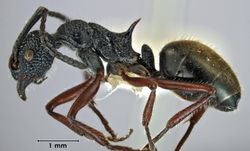Key to Dolichoderus of the southwestern Australian Botanical Province
This key to workers is based on: Heterick, B. E. 2009a. A guide to the ants of South-western Australia. Records of the Western Australian Museum, Supplement 76: 1-206. Part 1.
You may also be interested in
1
- Propodeum armed with a pair of sharp spines (ypsilon group) . . . . . 2
- Propodeum unarmed . . . . . 5
2
return to couplet #1
- Femur, tibia and tarsi light red or orange . . . . . 3
- Femur, tibia and tarsi dark reddish-brown or black . . . . . 4
3
return to couplet #2
- Viewed from front, propodeum spines directed upward at angle of greater than 60° to horizontal plane (may be almost vertical) (Figure 135) . . . . . Dolichoderus angusticornis
- Viewed from front, propodeal spines directed upward at angle of 45° or less to horizontal plane (Figure 136) . . . . . Dolichoderus ypsilon
4
return to couplet #2
- Femur, tibia and tarsi black; pubescence on gaster off-white . . . . . Dolichoderus niger
- Femur, tibia and tarsi dark reddish-brown; pubescence on gaster yellow . . . . . Dolichoderus rufotibialis
5
return to couplet #1
- Declivitous face of propodeum straight (Figure 137); head smooth and shining . . . . . Dolichoderus parvus
- Declivitous face of propodeum weakly to strongly concave (Figure 138); head with distinct sculpture . . . . . 6
6
return to couplet #5
- Pronotal sculpture weakly rugose-punctate, or sculpture largely lacking (Figure 139) . . . . . 7
- Pronotal sculpture distinctly foveate-reticulate (Figure 140) . . . . . 9
7
return to couplet #6
- Standing setae on head, antennal scapes, mesosoma and gaster sparse and short (≤ greatest width of antennal scape), sparse or absent on tibiae; usually pale, depigmented . . . . . Dolichoderus sp. JDM 1106
- Standing setae on head, antennal scapes, mesosoma and gaster abundant and longer (longest setae >> greatest width of antennal scape), present on tibiae; body bicoloured (mesosoma orange to yellowish-brown, gaster and often head brown) . . . . . 8
8
return to couplet #7
- Dorsum of propodeum strongly convex, carina separating dorsal and declivitous faces of propodeum not produced as a sharp shelf (Figure 141); without pale markings near lower margin of eyes; sculpture of pronotum almost lacking, pronotum shining . . . . . Dolichoderus clusor
- Dorsum of propodeum weakly convex, carina separating dorsal and declivitous faces of propodeum produced as sharp shelf (Figure 142); pale markings present near lower margin of eye; sculpture of pronotum weakly rugosepunctate . . . . . Dolichoderus sp. JDM 513
9
return to couplet #6
- Propodeal dorsum not evenly convex, declivitous face very deeply concave, concavity almost semi-circular (Figure 143) . . . . . Dolichoderus reflexus
- Propodeal dorsum evenly convex, declivitous face less deeply concave, concavity much less than a semi-circle in extent (Figure 144) . . . . . 10
10
return to couplet #9
- Antenna much darker than head . . . . . Dolichoderus nigricornis
- Antenna the same colour, or slightly lighter in colour than head . . . . . Dolichoderus formosus



























